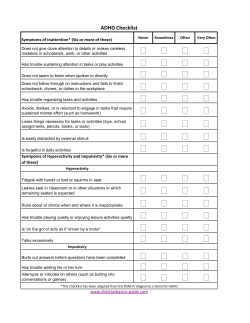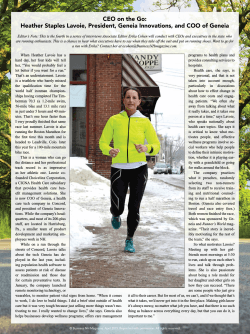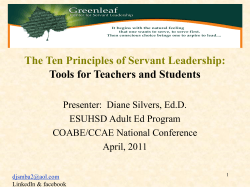
How To Help Our Kids Get On The Right Track With Communication
How To Help Our Kids Get On The Right Track With Communication And Social Skills Presented by: • • • • • • • • • • • Skosh Jacobsen, L.M.H.C. Parenting Educator for two excellent programs Chemical Dependency Professional Trainee Member of the Board of the Puget Sound Adlerian Society for 8+ years Member of ADD Resources for 4+ years Facilitator for a women’s group with Celebrate Recovery in Maryville for 5 years Specializing in ADD/ADHD and associated disorders, marriage and family, grief and loss Locations in: Bellevue, So Snohomish, Marysville (425) 330-3898 email: Skosh@skosh.org Website: skosh.org 2 We are social creatures. • Research bears out that we are social creatures. • We do best in groups. • Living in groups can be a mystery, unless we have a mutually agreeable code of acceptable behaviors. 3 Children with special needs • Children with special needs often do not read signals very well: – Facial expressions – Vocal tones and volume – Body language 4 What are some things your children struggle with? • Some kids struggle with: – Loudness – Discretion – High energy – Temper – Impulsivity 5 What are some things your children struggle with? • Other kids struggle with: – Shyness – Low energy – Lack of assertiveness – Fear or anxiety – Just plain confused 6 Resources: Books for Kids with ADHD/ADD • The Survival Guide for Kids with ADD or ADHD by John F. Taylor, Ph.D. • A Bird’s-Eye View of Life with ADD and ADHD By Chris A. Zeigler Dendy and Alex Zeigler Books for Adults • What Does Everyone else Know That I Don’t? by Michelle Novotni Written for adults, this book offers tips on communicating, manners, and strategies to help put these into practice. 7 Books for Parents • How to Talk So Kids Will Listen and Listen So Kids Will Talk Adele Faber and Elaine Mazlich • Positive Discipline and all associated titles Jane Nelsen and friends • Raising Self-Reliant Children in a SelfIndulgent World H. Stephen Glenn and Jane Nelsen • Parenting from the Inside Out Daniel Siegel and Mary Hartzell • Raising an Emotionally Intelligent Child John Gottman (The Heart of Parenting) 8 Last One Picked…First One Picked On by Richard Lavoie Michelle Novotni in her book What Does Everyone Else Know That I Don’t? describes the video Last One Picked…First One Picked On by Richard Lavoie. Richard Lavoie works with children with learning disabilities. He suggests that schools ought to teach what he calls “the hidden curriculum”, referring to the unspoken rules about social issues: “who to sit with at lunch, how to make friends, who’s safe and who’s not, where to find help, avoiding getting beaten up…" Written for adults, What Does Everyone Else Know That I Don’t? offers tips on communicating and manners, and strategies to help the person with ADHD put these into 9 practice. What works? There are a variety of tools that I use with children. I draw these tools from the Developing Capable Young People and Positive Discipline Programs. 10 The Psychology of Alfred Adler and Rudolf Driekurs • Behavior is aimed at: –Internal sense of belonging –Significance • Equality in the form of Mutual Respect • “The Courage to be Imperfect” –Mistakes are opportunities to learn 11 Adler and Driekurs Ideas: Misbehavior is based on: • Mistaken beliefs about how to achieve belonging and significance • Shows up most often when children do not have skills to connect or feel valued in socially useful ways 12 A Misbehaving Child is a Discouraged Child So, when we use the word “discipline”, we are referring to actions that can be taken by the ADULT to help the CHILD to find how to belong and to find meaning in socially acceptable ways. 14 First of all -- -- -- -• • • • EYE CONTACT EYE LEVEL A QUIET VOICE rather than intense voice RESPECT THEIR SPACE by being about an arm’s length distance away from them. Some young children can struggle with intense eye contact like a glare or a sense of (over) crowding – it feels “dangerous” to them 15 CONNECTION IS ESSENTIAL in order to help our children in any way. Eye contact, eye level, a quiet voice, respecting their space – PLUS a PAUSE to THINK THROUGH BEFORE WE SPEAK – AND 16 Understanding how children are affected By their special needs: • • • • • • ADHD ASPERGERS’ High functioning Autism Sensory Integration Issues Behavioral Disorders (alphabet soup) By their developmental level 17 Developmental Levels 2 – 6 Preoperational 6 – 11 Concrete 11 + Abstract/Conventional Thinking 18 2 – 6 Preoperational • At this stage, children only see one aspect of a situation at a time. • Their thinking is rigid – • either/or • safe/dangerous • GOOD/BAD Maybe because of limits in their vocabulary, their thinking can only grasp the extremes, and if you do a good thing, YOU ARE GOOD and if you do a bad thing, YOU ARE BAD and so they internalize or take inside themselves these states that they can’t reconcile and are left BANKRUPT! 19 6 – 11 Concrete At these ages, children are beiginning to understand abstract relationships. They are able to use logical thought when solving problems involving concrete objects, events, or ideas like: • Cause/Effect • Legal/Illegal • Explore “What will happen if_____?” qs 20 11 + Abstract/Conventional Thinking During this stage, young people become capable of dealing with hypothetical concepts. They can discriminate between abstract concepts, such as: • Appropriate/Inappropriate • Fair/Unfair • “How might ______ feel about you doing ______?” questions 21 Brain Differences • The brain does not fully gel until mid-20s, and later for those with ADHD/ADD and we don’t know what else. • Therefore, children have learning differences, and when we can understand and accept their limitations, instead of thinking that they are faking or trying to get attention, we can cut down on resistance and get on with the task of adjusting, of working together, of growing. 22 The Brain and Emotions • The brain functions to string events together Example, if I smash my thumb, my brain is going to think back to every time that I have done that and will pull up the biggest impacting memory (i.e., the last or worst) Negative memories make a deeper impact on the brain cell and surface first THEY JUST DO. 23 Emotions • Are neither right or wrong • We either think or feel BUT we don’t do both very well at the same time, unless we’ve been trained (I.e., such as an E.R. doctor or fireman) When feelings are HIGH the BRAINS CHECK OUT 24 Alternatives could be • Use of humor (Example: rewind technique) • Taking a respectful time out and agreeing to come talk about the situation when feelings are calmer • Listening to the hurting person’s feelings and validating in an understanding way 25 Validating • • • • • • • • Not being mushy Not condoning inappropriate behavior Not giving in Not demanding the parent’s way as only way Is kind and respectful Gives space for a person to let out feelings Waits to be heard Gives listening cues and is attentive 26 Next we want to understand the perception behind the behavior • Perceptions affect attitudes, motivation, and behavior. If we can understand the belief behind an action, we can be more effective. • Perceptions are unique. We are all different • Perceptions are cumulative, a compilation of our history and every experience we’ve ever had • Perceptions need to be supported in order for others to let go and consider a different 27 position. EIAG • Perceptions are the product of a four-step process, thinking broken down into segments: Experience + Identify+ Analyze + Generalize = EIAG We use “what” and “how” questions to explore with the child what their belief is, to consider possibilities, and to collaborate on solutions – with a sincere attitude. We are solution-focused, instead of problem-focused. By collaborating, we bring the other person “on board” and they are more invested in solutions that are their ideas. 28 An Experience Happens • Identify – – – – What happened? What did you see? What were you feeling? What was important? • Analyze – – – – What do you think caused that? What did you want to see happen? Why was that important? What was meaningful about that? • Generalize – – – – What do you want to do with this now? How is this useful for you? What will you need to change for the future? What wisdom did you gain from this? 29 A WORD OF CAUTION These questions need to be spoken from a sincere or genuine or gentle heart. If we use this to manipulate, we are not helping our children at all. We are trying to learn how to do WITH the child, not TO the child. 30 Attitudes Required for Effective Listening • A desire to hear what a child has to say • A willingness to see things from the child’s perspective • A desire to help the child explore a problem • Acceptance of the child’s feelings • A belief that the child is capable and able to understand their own problems and feelings 31 Principles of Good Listening We Model by using: • “I” statements • Paraphrasing • Taking turns to talk and listen • Respecting others’ observations and ideas • Checking perceptions by getting feedback • Or clarification • Negotiating and demonstrating give/take • Showing empathy • Focusing on the other person’s point of view 32 Makes a world of difference! • Spending time, chilling out, letting them squawk, listening, tossing ideas around, BEING AN EXAMPLE 33 So, how do we help our children learn social skills? We can show them how to be uncool, or we can show them how to regroup and do better the next time …..and….. 34 We can set up opportunities to try on new ideas and learn skills: • We can grab some McDs and take it home and practice eating out in small manageable doses • We create mini-outings at home, gradually working our way up to candlelight and fancy dishware • Taking time to train is the KEY 35 Mistakes Happen • We can learn to use mistakes as opportunities to show grace and innovation, helping our children discover new ways to work through challenges that they may face, and prepare for those painful disappointments that will inevitably come • We can go back after a flop when we are calm and discuss what went wrong and what we wanted to see happen – and 36 invite them to work collaboratively We learn: • to not deal with a conflict when feelings are high • to find better timing to help us to be more effective • to make constructive use of time out • to never use time out as a rejecting or punishing thing, but as a cool down tool • to take time outs for ourselves as examples • We can take our child and find time-out spots 37 We learn: • to look at the long-term costs and benefits of our own behavior and our example • to get rid of the crazy idea that we have to make children feel worse to get them to do better • teach and model mutual respect by being kind and firm: kind to respect the child and firm to respect yourself (This can be challenging, so timing helps) 38 We learn: • that giving children special time can open up special opportunities to touch their lives When we give a child five minutes of focused attention a day spending special time, even “problem children” show a huge improvement. 39 We learn: • that family meetings and class meetings present perfect opportunities to practice these ideas: • modeling • mutual respect • helping children learn self-discipline • cooperation • problem-solving skills • Negotiating • responsibility 40 And all the time we’re modeling for them better ways to be in the world 41 and molding their future for a life that they really can succeed in 42
© Copyright 2025





















